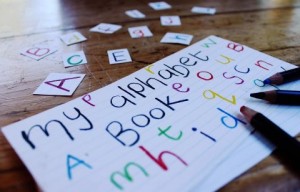 Some environments are print rich. They are full of print that is used and displayed for different purposes – signs, notices, advertisements, magazines, newspapers, books, timetables, posters, letters, cards and so on. These may be in one language, or in two or more languages.
Some environments are print rich. They are full of print that is used and displayed for different purposes – signs, notices, advertisements, magazines, newspapers, books, timetables, posters, letters, cards and so on. These may be in one language, or in two or more languages.
Some environments have very little print. Others have none at all.
It is easier for children to learn to read and write in an environment that has lots of print in it because it shows them what reading and writing can be used for. Here are some ideas for how to make your reading club’s meeting place a print-rich environment.
Posters
- Make your own posters using drawings or pictures from old magazines and newspapers. You can write your own message or slogan in one, two or more languages.
- Make posters using rhymes, songs and riddles in different languages. Ask the children and their family members for suggestions and use ones you know.
- Read them with the children, pointing to the words as you read.
- Encourage the children to read and re-read them by themselves or with friends.
- Allow the children to copy the posters and make their own small versions to take home and share with their families.
- Display posters where the children can see them easily. Remember to replace them regularly so that the children do not become bored by them.
Alphabet charts
Alphabet charts let children see what letters exist, and you can use them to help match letters to sounds. Make and display different kinds of alphabet charts. Draw pictures for each letter that would be meaningful to the children at the club – or better still, ask each child to draw a picture for each letter and use these to create your own alphabet charts. Children love to make an alphabet picture of themselves using the first letter in their name.
Lots to read
Be a collector of things to read that others have finished reading! But make sure that you will want to use whatever you collect. Collect newspapers and magazines, menus from take-away outlets, information pamphlets, train or bus timetables and old greeting cards. These sometimes contain interesting things to read, can be props to act with or can be cut up and used by the children when they make their own cards, pictures etc. Ask friends and family to donate a book to your reading club when it is their birthday.
Be a role model
One of the reading club volunteer’s tasks is to be a role model for reading and writing. Read to and with the children. Write for and with the children.

